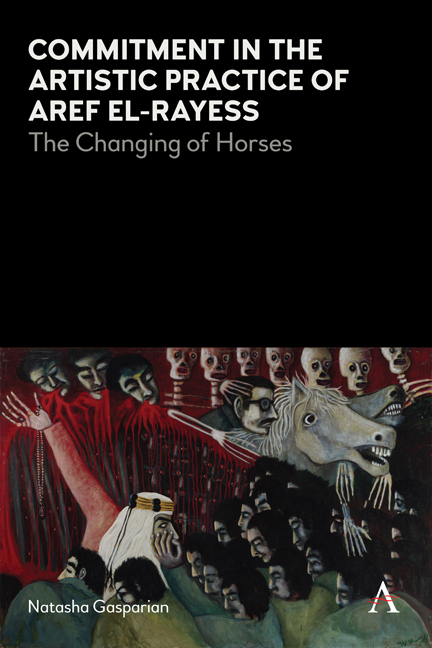1 - The Exhibition
Published online by Cambridge University Press: 22 February 2022
Summary
Aref El-Rayess's The Changing of Horses (Figure 1.1) was first exhibited at Salle de L’Orient in April 1968, in an itinerant solo exhibition of 13 oil paintings entitled Dimaʾ wa Hurriyya in Arabic and Sang et Liberté in French (Blood and Freedom). It was the centerpiece of the exhibition display, and it provided the narrative context for the other 12 works, which included homages to the revolutionary figures Che Guevara (assassinated in October 1967) and Martin Luther King (assassinated in April 1968), to the French president Charles de Gaulle and to the armed guerrilla combatants of the Palestinian Resistance (the fidāʾiyīn), as well as scenes of struggle and protest in Lebanon, Palestine and Vietnam.
Blood and Freedom opened just nine months after the colossal defeat of Egyptian, Syrian and Jordanian military and paramilitary forces by the Israel Defense Forces (IDF), which seized the Gaza Strip, the Sinai Peninsula and the Golan heights in as little as six days in June 1967. In an effort to recover swiftly from the devastating events, the official discourse in Arab states historicized the June War in euphemistic terms, as the Naksa (setback), following Abdel Gamal Nasser's use of the term on the last day of the war. The local and regional press symbolically referred to the war by the first day of battle, as “The 5th of June,” to which El-Rayess owed the commemorative title of his painting. Although Lebanon was the only state of occupied Palestine's neighbors not to partake in the war, the effects of the Arab defeat were instantly apparent on the streets of Beirut. Daily life was interrupted by bank closures, breaks in the working day and live news broadcasts. On the last day of the war, the Coca-Cola bottling plant was burned as a response to the company's investments in Israel, and in the evening, Nasser declared defeat in his resignation speech, which was broadcast throughout the region. Samir Kassir compares the upheavals that followed in Beirut to those in Cairo, where “thousands and thousands of people descended into the streets to proclaim their refusal to accept defeat and their loyalty to the vanquished leader [Nasser …] and to execrate the United States, which no one doubted for one moment had been the true instigator of this lightning war.”
- Type
- Chapter
- Information
- Commitment in the Artistic Practice of Aref El-RayessThe Changing of Horses, pp. 7 - 16Publisher: Anthem PressPrint publication year: 2020



